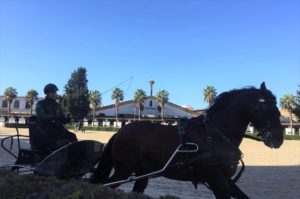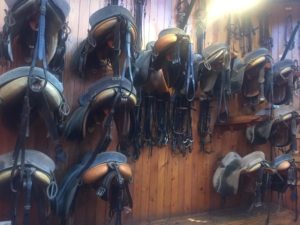 White horses ride in perfect formation, movement almost completely synchronised, around a sand strewn indoor arena in southern Spain.
White horses ride in perfect formation, movement almost completely synchronised, around a sand strewn indoor arena in southern Spain.
The arena is in the grounds of the Real Escuela del Arte Equestre, which is well worth visiting if you are in Jerez. The School, which was founded in the 1970s, builds on the long equestrian tradition in the town and its hinterland, which  goes back to the Moorish occupation and Christian reconquest. Horse breeding has been a big part of life here for many generations, especially out at the Monastery of Cartuja, with its famed Cartuja horses (the breed which eventually became Lipizaners). The annual Feria de Caballo, or Horse Fair, was established by King Alfonso X in the thirteenth century ( see Andalucian Spring ).
goes back to the Moorish occupation and Christian reconquest. Horse breeding has been a big part of life here for many generations, especially out at the Monastery of Cartuja, with its famed Cartuja horses (the breed which eventually became Lipizaners). The annual Feria de Caballo, or Horse Fair, was established by King Alfonso X in the thirteenth century ( see Andalucian Spring ).
The School is dedicated to preserving the Andalucian breed of horses and provides education in all aspects of horsemanship and associated crafts – dressage, country riding, carriage driving, blacksmithing, saddlery etc.. It is very difficult to get into, with applicants having to pass both written and practical examinations and only six  students, from the age of 16, being taken per year. Thereafter their hours are devoted to all aspects of equestrianism, including looking after the horses. They do not ride just one horse but many, the idea being that their skills improve regardless of their mount. All the horses are stallions, brought here from the breeding farm aged three years old, while the mares and foals remain in the countryside. They may begin as brown but eventually they become grey and then white. The horses and students perform once a week ( twice in Summer ) an exhibition in the arena, which is a mixture of dressage and performance by the unmounted horses.
students, from the age of 16, being taken per year. Thereafter their hours are devoted to all aspects of equestrianism, including looking after the horses. They do not ride just one horse but many, the idea being that their skills improve regardless of their mount. All the horses are stallions, brought here from the breeding farm aged three years old, while the mares and foals remain in the countryside. They may begin as brown but eventually they become grey and then white. The horses and students perform once a week ( twice in Summer ) an exhibition in the arena, which is a mixture of dressage and performance by the unmounted horses.
The school premises on Avenida de Duque de Abrantes include the stables and arena as well as outdoor training facilities. It is not just a place to see the horses and students training, but also various other elements within the  grounds and gardens of this eighteenth century palace. There is a working saddlery and a dressage square. Storks nest atop the stable buildings. The ground floor of the palace itself is open to visitors, although the rest is used as offices and meeting rooms. See if you can find all twelve signs of the zodiac in the intricate painting of the doors which connect the series of rooms along the rear.
grounds and gardens of this eighteenth century palace. There is a working saddlery and a dressage square. Storks nest atop the stable buildings. The ground floor of the palace itself is open to visitors, although the rest is used as offices and meeting rooms. See if you can find all twelve signs of the zodiac in the intricate painting of the doors which connect the series of rooms along the rear.
In the palace basement is the Museum of the Horse, which covers not just the evolution of equus, but also how the horse has been bred – in the UK for speed, in Germany for strength, in Spain for intelligence. How horses have been used, since very ancient times and how the equipment to use them was developed, the introduction of saddles, of stirrups, of the tack we use today. It’s very interesting. The Tack Room in the stables is testament to this and to the expertise of the saddlers.
A full tour, including a tour of the stables takes at least a couple of hours, even if you’re not going to see the performance and the Escuela closes at two, so be sure to leave enough time to see everything. A separate Carriage Museum can also be visited.
For more things to do in Jerez try Jerez in the Rain Semana Santa in Jerez Verano en Jerez Vendimmia


 RSS – Posts
RSS – Posts